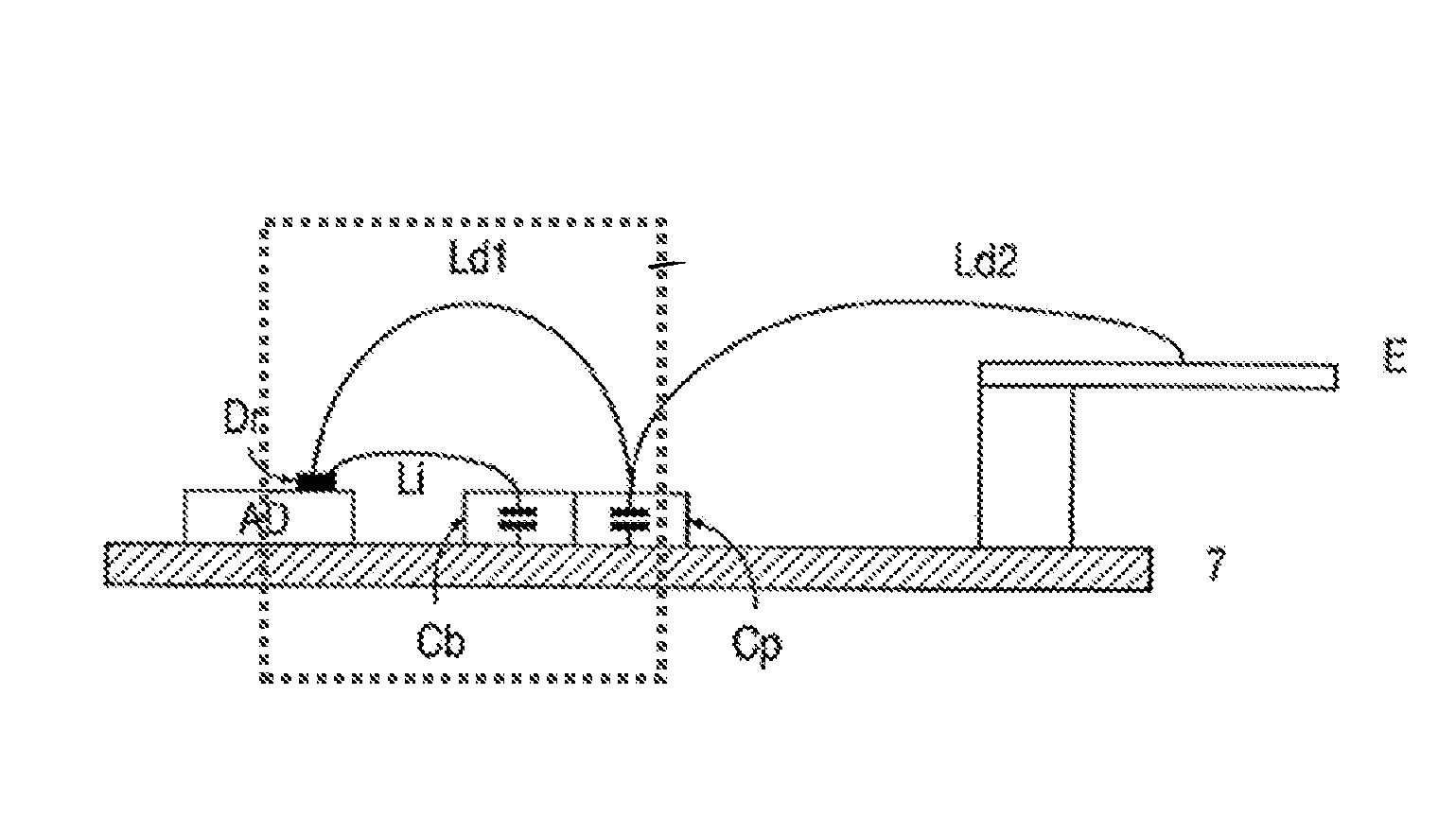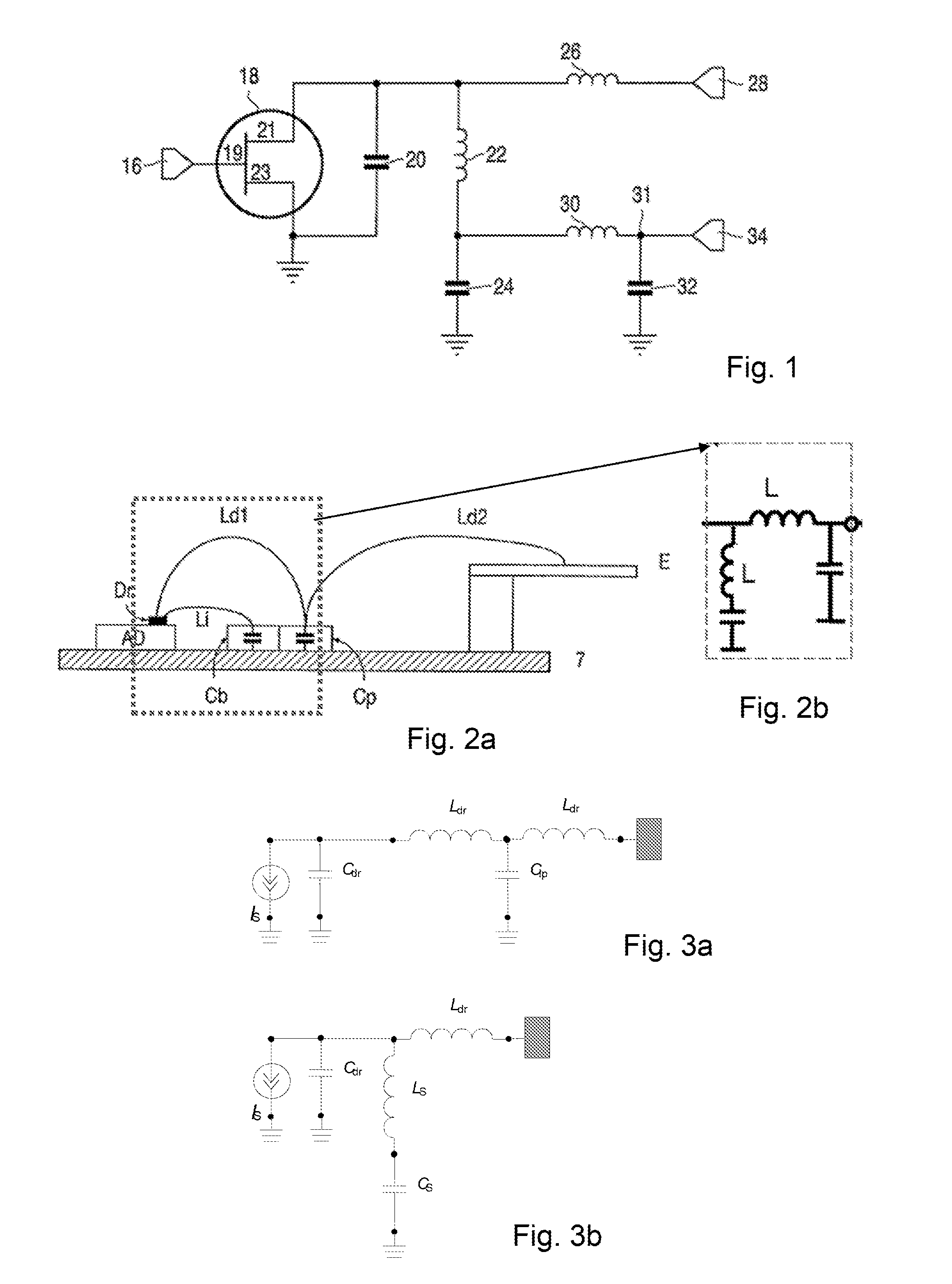Radiofrequency amplifier
a radiofrequency amplifier and amplifier technology, applied in amplifiers with semiconductor devices/discharge tubes, amplifier modifications to extend bandwidth, semiconductor devices, etc., can solve the problems of large distortions due to memory effects, particularly problematic memory effects, etc., to improve bandwidth, reduce memory effects, and facilitate load line modulation conditions
- Summary
- Abstract
- Description
- Claims
- Application Information
AI Technical Summary
Benefits of technology
Problems solved by technology
Method used
Image
Examples
first embodiment
[0040]A first exemplary embodiment of a radiofrequency amplifier 500 in accordance with the invention is illustrated in FIGS. 5a, 5b and 5c. FIG. 5a illustrates a schematic sectional view of the amplifier, FIG. 5b a schematic circuit diagram of the amplifier 500 and FIG. 5c a perspective view of the physical arrangement of the amplifier 500. Each of these diagrams show an active device AD 501 having an output 502 connected to a first RF output lead 503 via a first bond wire Ld BW 504, and to a second output lead 505 via a second bond wire Ls BW 506, each bond wire providing an inductance between the amplifier output 502 and the output leads 503, 505. In this illustrated embodiment the output 502 of the active device 501 is the drain connection of the active device 501.
[0041]This implementation is similar to known post matching circuits for RF power amplifiers in which a built-in shunt inductance (or ‘inshin’) is used to cancel the output capacitance Cds 507 of the amplifier element ...
second embodiment
[0046]A second embodiment of a radiofrequency amplifier 600 in accordance with the invention is illustrated in FIGS. 6a, 6b and 6c. FIG. 6a illustrates a schematic sectional view of the amplifier 600, FIG. 6b a schematic circuit diagram and FIG. 6c a general perspective view of the physical arrangement of the amplifier 600.
[0047]The main difference with respect to the first embodiment described above and illustrated in FIGS. 5a-5c is the addition of a series capacitor Cser 621 to the output of the active device 501 (601 in FIGS. 6a and 6c). All other components of the amplifier 600 are otherwise as described above in relation to the first embodiment. The series capacitor 621 can be provided either on the active device 601 as part of the output as shown in FIGS. 6a and 6c or, as shown in FIG. 6b, on a separate die. The series capacitor 621 acts to compensate for the inductance of the first output RF lead 503. This is particularly advantageous for so-called “gull wing” packages, where...
third embodiment
[0050]The amplifiers of either the first or second embodiments can be further improved through the use of a special transmission line instead of through the simple metal strip forming the second output lead of the first and second embodiments.
[0051]At frequencies close to 1 Ghz the inductance introduced by extra leads and the PCB can reach values which are not usable for post match and video decoupling, due to the value of the parasitic inductance between the ground connections of the PCB and the active die (as described above in relation to FIG. 5b). In order to minimize this parasitic inductance, a special transmission line may be used instead of the simple metal strip inside the amplifier package. Exemplary embodiments of such transmission lines are illustrated in FIGS. 8 and 9. FIG. 8 shows a series of plan views of three variations of a transmission line 801a, 801b, 801c based on a modified version of the second output lead of the first and second embodiments. The modified seco...
PUM
 Login to View More
Login to View More Abstract
Description
Claims
Application Information
 Login to View More
Login to View More - R&D
- Intellectual Property
- Life Sciences
- Materials
- Tech Scout
- Unparalleled Data Quality
- Higher Quality Content
- 60% Fewer Hallucinations
Browse by: Latest US Patents, China's latest patents, Technical Efficacy Thesaurus, Application Domain, Technology Topic, Popular Technical Reports.
© 2025 PatSnap. All rights reserved.Legal|Privacy policy|Modern Slavery Act Transparency Statement|Sitemap|About US| Contact US: help@patsnap.com



